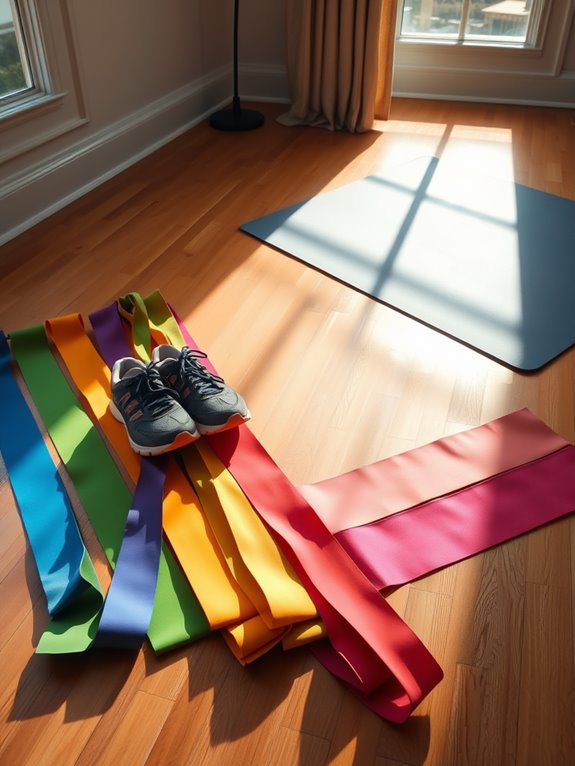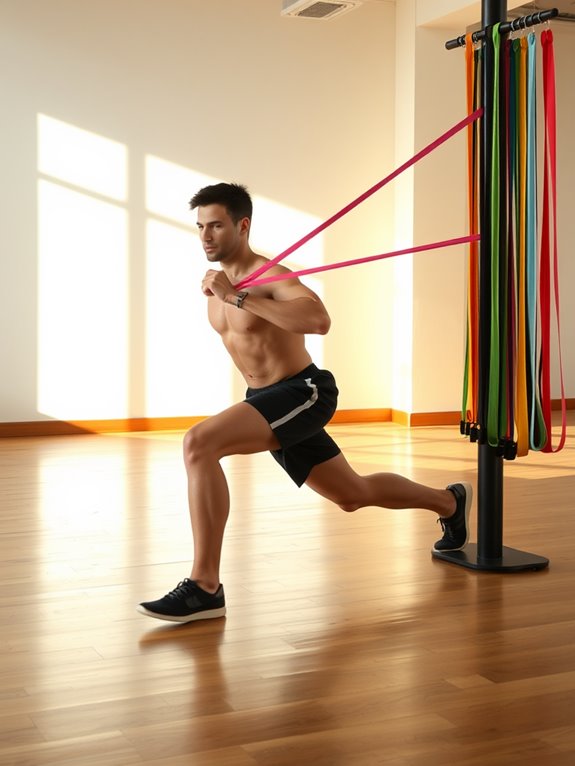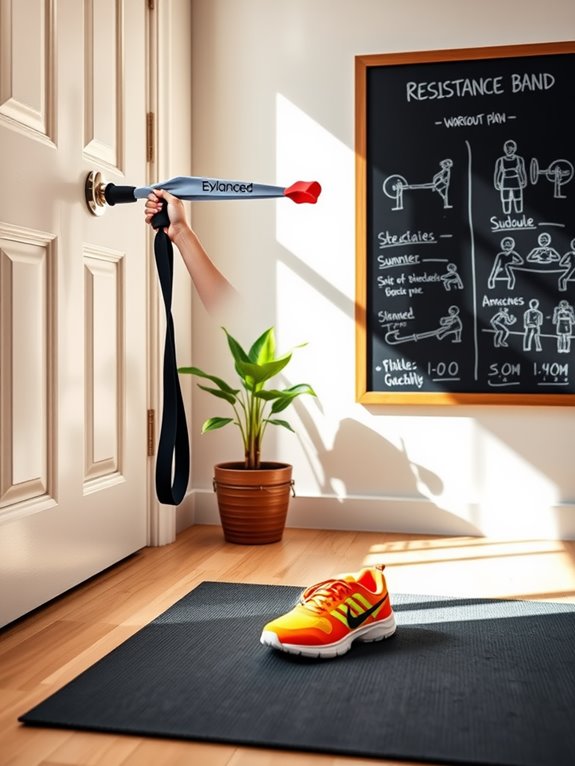To get a great workout with just a resistance band, start by choosing the right band based on resistance level and length. Incorporate full-body exercises like squats, chest presses, and seated rows to target multiple muscle groups. Don’t forget to include flexibility stretches to improve your range of motion. Keep your workouts diverse and track your progress to stay motivated. There’s so much more you can achieve with bands, so let’s explore how to maximize your routine!
Nomad Highlights
- Choose a resistance band with appropriate tension for your fitness level to ensure effective workouts.
- Incorporate a variety of exercises, such as squats, chest presses, and seated rows, for a full-body workout.
- Focus on maintaining proper form and technique to prevent injuries and maximize workout effectiveness.
- Use bands for both strength training and flexibility exercises to enhance overall performance and recovery.
- Track your progress and set achievable goals to stay motivated and engaged in your resistance band workouts.
Understanding Resistance Bands: Types and Benefits

Resistance bands typically come in three main types: flat bands, tube bands, and loop bands. Flat bands are versatile for various exercises, while tube bands usually have handles, making them great for strength training. Loop bands, often used for lower body workouts, provide excellent resistance for squats and glute exercises. Additionally, many resistance bands are made of high-quality materials that ensure durability and longevity throughout your workouts. Natural latex bands are particularly recommended for their non-toxic and anti-slip properties, enhancing your workout experience. Ankle resistance bands can also include various accessories to complement your resistance band workouts.
Moreover, resistance bands are suitable for various training styles, allowing you to target multiple muscle groups effectively.
Each type offers unique advantages, such as portability and ease of use. By incorporating these bands into your routine, you’ll not only increase strength but also improve flexibility and stability. Embracing resistance bands can take your fitness journey to new heights, making your workouts more effective and engaging.
Getting Started: Choosing the Right Resistance Band

When you’re ready to start using resistance bands, it’s important to choose the right one for your needs.
Consider the types of bands available, the resistance levels they offer, and the proper length for your workouts. Choosing bands made from 100% natural latex will enhance their durability and elasticity. Additionally, adjustable dumbbells can complement your resistance band workouts by providing varied weight options for strength training. Making the right choice will set you up for an effective and enjoyable experience. Incorporating stretching straps into your routine can further enhance flexibility and recovery, allowing for a more comprehensive workout. Many users find that adjustable resistance settings in their equipment can significantly improve the effectiveness of their workouts. Moreover, using bands with thousands of stimulation points can mimic the benefits of acupressure mats, promoting relaxation and muscle recovery.
Types of Resistance Bands
Resistance bands come in various types, each designed to suit different fitness levels and workout goals. You’ll find flat bands, which are great for yoga and Pilates, as they provide versatility and can target multiple muscle groups. Additionally, these bands are a popular tool among fitness enthusiasts for their ability to provide resistance without heavy weights. Many athletes also appreciate how resistance bands can enhance functional strength and improve overall performance. Using unique products like resistance bands can help diversify your workout routine and keep you motivated.
Tube bands with handles are ideal for strength training and offer a secure grip during exercises. Moreover, foldable resistance trainers can complement your resistance band workouts by providing additional options for strength and flexibility training. Mini bands are perfect for lower body workouts, helping to improve strength and stability in your hips and glutes. Loop bands can be used for both upper and lower body workouts, adding resistance to your movements. Finally, figure-eight bands are excellent for toning arms and shoulders. Additionally, resistance bands are an excellent addition to fitness regimens, enhancing workout routines across strength training, flexibility, and rehabilitation.
Band Resistance Levels
Choosing the right band resistance level is essential for getting the most out of your workout. Resistance bands come in various levels, and selecting one that suits your strength and fitness goals will guarantee you’re challenged but not overwhelmed. Here’s a quick guide to help you choose:
| Resistance Level | Ideal for Beginners | Ideal for Advanced Users |
|---|---|---|
| Light | Beginners, rehab | – |
| Medium | General fitness | Intermediate strength |
| Heavy | – | Advanced strength training |
Start with a lighter band if you’re new, and as you grow stronger, upgrade to a medium or heavy band. Remember, the right resistance keeps your workouts effective and enjoyable! Additionally, exploring options like adjustable kettlebells can further enhance your fitness routine and versatility in workouts. Unique products for every lifestyle can help you find the perfect tools to complement your training. Incorporating adjustable dumbbells can also provide a versatile strength training experience. Understanding DPI settings range can help you select the best resistance for your needs. Motor output and RPM are critical factors that can influence the effectiveness of your workouts when using resistance bands.
Proper Band Length
Finding the right band length is essential for making the most of your workouts. When choosing a resistance band, consider your height and the types of exercises you’ll be doing.
Generally, a band should be about twice your height when stretched. This allows for a full range of motion without snapping back unexpectedly. If you’re using the band for lower body exercises, opt for a longer band to guarantee it can accommodate your movements. Additionally, exercise dice can enhance engagement in your routines by introducing variety and fun elements to your workouts. Choosing the right band also ensures that you can maximize resistance training effectively for each exercise. It’s important to remember that handle comfort and grip are key factors in maintaining stability during resistance training. Furthermore, incorporating tools like portable balance boards can further improve stability and enhance your workout effectiveness.
For upper body workouts, a shorter band may suffice. Don’t hesitate to experiment with different lengths; finding the perfect fit will enhance your performance and comfort. With the right band length, you’ll maximize your resistance training and achieve better results. Additionally, using exercise sliders can enhance various workouts by improving core engagement and overall workout intensity.
Safety Tips for Using Resistance Bands

Before you start your workout, make sure to inspect your resistance bands for any signs of damage. Using proper technique is essential to prevent injuries and maximize your results. Additionally, ensuring that your workout equipment is stable and safe, similar to the features of portable pull-up bars, can help enhance your workout experience. Incorporating high-density EVA foam rollers into your routine can also aid in muscle recovery and improve overall performance. Regular use of stress relief squeeze balls can also complement your workout by enhancing focus and reducing anxiety.
Inspect for Damage
To guarantee a safe workout, it’s essential to inspect your resistance bands for any signs of damage before each use. Look for tears, frays, or discoloration, as these can indicate wear and tear. If you notice any issues, don’t hesitate to replace them. A damaged band can snap during your workout, leading to injuries. Regular maintenance is important to ensure that your equipment remains durable and effective for your fitness journey. Additionally, using high-quality bands can enhance your workout experience and minimize the risk of damage, leading to safer and more effective exercise sessions. Investing in unique products can also provide you with the right tools to elevate your fitness routine. A proper inspection routine is similar to ensuring filtration efficiency in air purifiers, which helps maintain optimal performance.
Here’s a quick checklist to help you assess your resistance bands:
| What to Check | Signs of Damage |
|---|---|
| Band Surface | Tears or frays |
| Band Color | Fading or discoloration |
| End Attachments | Loose or broken clips |
Additionally, ensure that your bands are made from high-quality, durable materials to minimize the risk of damage during workouts.
Use Proper Technique
Using proper technique is essential when incorporating resistance bands into your workout routine.
Always start with a stable base; verify your feet are shoulder-width apart for better balance. When performing exercises, maintain a neutral spine and engage your core to prevent injury. Fitness trackers can help monitor heart rate and ensure you are working within your optimal range for safety and effectiveness.
Avoid jerky movements; instead, control the band during both the contraction and release phases. Keep your elbows slightly bent to protect your joints, and never overstretch the band beyond its limits.
Focus on your form rather than the amount of resistance; quality over quantity is key. Finally, listen to your body—if something feels off, stop and reassess your technique. Additionally, consider incorporating adjustable dumbbells into your routine for enhanced strength training versatility.
Full-Body Resistance Band Workout Routine

A full-body resistance band workout routine can transform your fitness game, offering a convenient way to build strength and flexibility without the need for bulky equipment.
Here’s a simple routine you can follow:
Explore this straightforward routine to enhance your fitness journey with resistance bands.
- Squats with Bands: Stand on the band, holding the handles at shoulder height. Lower into a squat, then push back up.
- Chest Press: Anchor the band behind you. Hold the handles and press forward, engaging your chest muscles.
- Seated Rows: Sit with your legs extended, loop the band around your feet, and pull the handles towards your torso, squeezing your shoulder blades together.
Incorporate these exercises into your routine, and you’ll feel stronger and more flexible in no time!
Targeting Specific Muscle Groups With Resistance Bands

While a full-body workout with resistance bands is fantastic for overall fitness, targeting specific muscle groups can enhance your strength training even further.
To focus on your arms, try bicep curls and tricep extensions. For your legs, incorporate squats and leg presses using the band for added resistance.
If you want to work your back, perform seated rows or lat pull-downs. Don’t forget your core; exercises like resistance band twists and front raises engage your abdominal muscles effectively.
Incorporating Resistance Bands Into Your Cardio Routine

Incorporating resistance bands into your cardio routine can elevate your workouts by adding an extra layer of intensity and engagement.
You’ll not only boost your heart rate but also challenge your muscles, enhancing overall effectiveness.
Here are three easy ways to integrate resistance bands into your cardio:
- Band-Enhanced Jumping Jacks: Loop the band around your wrists to add resistance as you perform jumping jacks, targeting your shoulders and core.
- Resistance Band High Knees: Secure the band under your feet and hold the ends at your sides. As you perform high knees, the band will increase the challenge.
- Band-Resisted Burpees: Wear the band around your waist while doing burpees to amp up the intensity and engage your muscles further.
Try these techniques to maximize your cardio sessions!
Advanced Resistance Band Exercises for Experienced Users

As you progress in your fitness journey, challenging yourself with advanced resistance band exercises can greatly enhance your strength and stability.
Try the single-arm row, anchoring the band under your foot and pulling it towards your hip. This works your back and biceps effectively.
Another great option is the resistance band squat to overhead press. Stand on the band, squat down, and as you rise, press the band overhead for a full-body workout.
For core stability, perform a banded plank by wrapping the band around your wrists and maintaining tension as you hold the plank position.
Finally, consider the banded lateral walk to engage your glutes.
Incorporating these exercises will help you build muscle and improve overall fitness.
Stretching and Flexibility Workouts With Resistance Bands

After mastering advanced resistance band exercises, it’s important to balance strength training with flexibility and mobility work.
Incorporating resistance bands into your stretching routine can enhance your flexibility and help prevent injury. Here are three effective stretches to try:
- Seated Hamstring Stretch: Sit on the floor with one leg extended. Loop the band around your foot, and gently pull the band toward you to deepen the stretch.
- Chest Opener: Stand tall, holding the band with both hands behind your back. Pull the band away from your body to open up your chest and shoulders.
- Quadriceps Stretch: Stand and loop the band around your ankle. Pull your foot towards your glutes for a deep quad stretch.
These stretches will improve your range of motion and overall flexibility.
Creating a Balanced Workout Plan With Resistance Bands

To create a balanced workout plan with resistance bands, you need to contemplate both strength and flexibility training. A well-rounded routine includes exercises targeting different muscle groups while also enhancing your flexibility. Here’s a simple layout to get you started:
| Day | Focus Area | Sample Exercise |
|---|---|---|
| Monday | Upper Body Strength | Banded Row |
| Tuesday | Lower Body Strength | Squats with Resistance Band |
| Thursday | Flexibility | Seated Band Stretch |
| Saturday | Core Stability | Band Russian Twists |
Incorporating these elements guarantees you’re not only building strength but also improving your range of motion. Stick to this plan, and you’ll notice improvements in both strength and flexibility over time.
Staying Motivated: Tracking Progress and Setting Goals
Staying motivated is essential for your success, especially when working with resistance bands. To keep your enthusiasm high, track your progress and set achievable goals.
Staying motivated is key to success with resistance bands—track your progress and set achievable goals to maintain your enthusiasm.
Here are three effective strategies:
- Keep a Workout Journal: Write down your exercises, reps, and resistance levels. This helps you see how far you’ve come and encourages you to push further.
- Set Short-Term Goals: Break your larger fitness objectives into smaller, manageable milestones. Celebrate these wins to maintain excitement.
- Regularly Update Your Routine: Change your exercises every few weeks to avoid monotony. This not only challenges your muscles but also keeps your workouts fresh and engaging.
Frequently Asked Questions
Can Resistance Bands Replace Free Weights Entirely?
Resistance bands can’t fully replace free weights, but they’re versatile and effective for many exercises. You’ll find that bands enhance your workouts, targeting muscles differently while also improving stability and flexibility. Mix them for best results!
How Do I Clean and Maintain My Resistance Bands?
Like a well-tuned instrument, your resistance bands need care. Wipe them down with a damp cloth after use, avoid harsh chemicals, and store them in a cool, dry place to keep them in top shape.
Are Resistance Bands Suitable for Rehabilitation Exercises?
Yes, resistance bands are great for rehabilitation exercises. They provide adjustable resistance, helping you strengthen muscles without overstraining. You’ll find them useful for improving flexibility, stability, and range of motion during your recovery process.
How Do I Increase Resistance in My Bands?
To increase resistance in your bands, you can shorten the length by pulling the band closer together or using thicker bands. You could also double the band over or add weights for extra challenge.
Can I Use Resistance Bands During Pregnancy?
Absolutely, you can use resistance bands during pregnancy. They’re versatile and can help maintain strength. Just listen to your body, avoid overexertion, and consult your healthcare provider to guarantee a safe and effective workout.
Conclusion
With resistance bands at your side, you’re not just working out; you’re releasing your inner fitness superhero! By understanding their versatility and incorporating various exercises into your routine, you’ll sculpt your body and boost your strength like never before. Remember to choose the right band, prioritize safety, and stay consistent. As you track your progress, you’ll realize that the possibilities are endless. So grab your resistance band and get ready to transform your workouts into something extraordinary!




